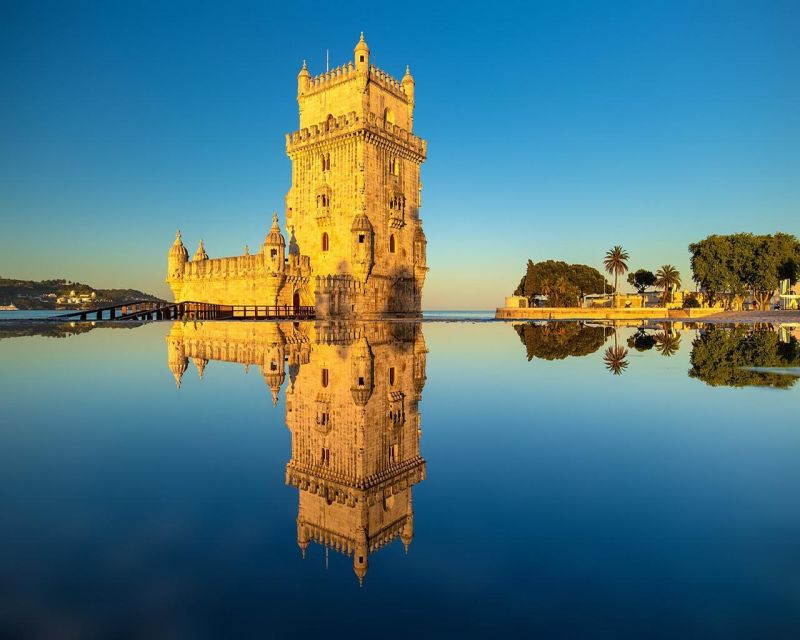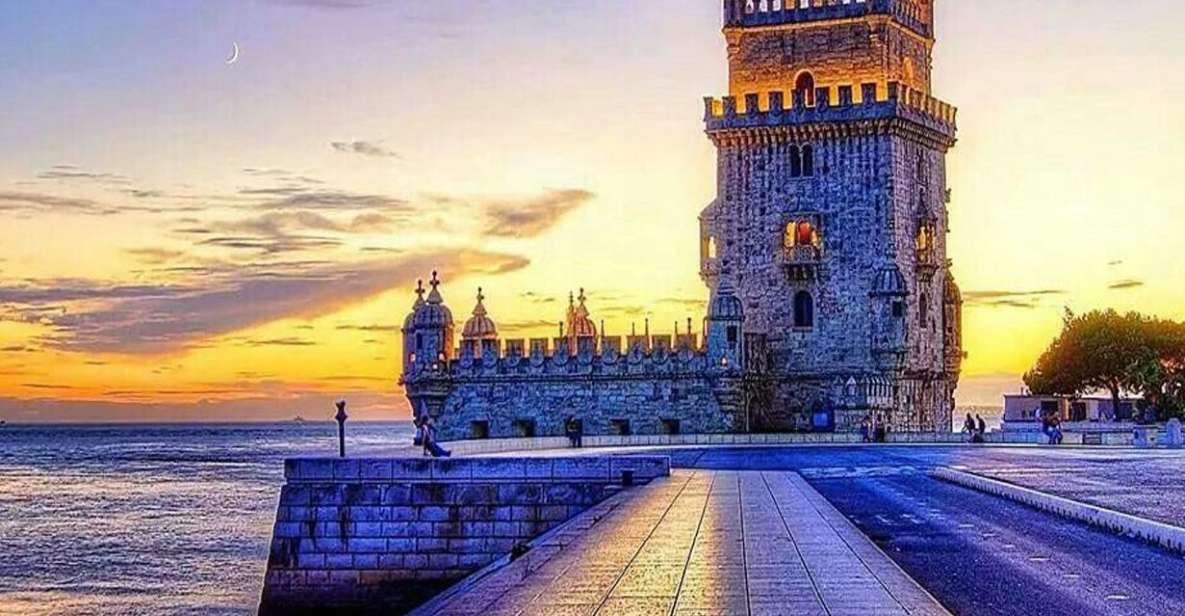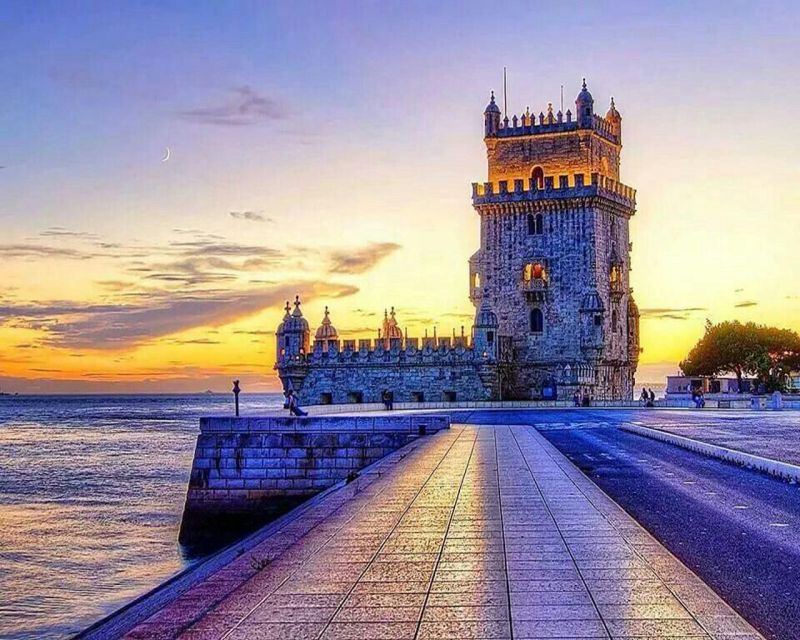Perched majestically along the Tagus River, Belem Tower‘s captivating silhouette has mesmerized visitors for centuries. This iconic 16th-century fortress blends Moorish grandeur with Manueline elegance, its intricate stonework and whimsical balconies reflecting Portugal’s seafaring legacy. Though it once served as a prison, today the tower stands as a testament to the country’s architectural prowess, its history intertwined with the ebb and flow of Portugal’s cultural narrative. Stepping inside, one can almost hear the echoes of the past, hinting at the wealth of stories waiting to be uncovered.
Key Points

- The Belem Tower features the ornate Manueline architectural style, blending European and Moorish influences with intricate sculptural ornamentation.
- The tower’s design is attributed to the collaboration between military architect Francisco de Arruda and master builder Diogo de Boitaca.
- Belem Tower served as a strategic military outpost and prison, with its commanding presence and fortified structure.
- The tower’s Manueline style ornamentation showcases symbols of maritime exploration and seafaring prowess, reflecting Portugal’s global ambitions.
- The tower’s geographical location along the Tagus River has transformed over the centuries, and it is now a designated national monument of Portugal.
We've also reviewed these top rated tours and experiences nearby.
Architectural Highlights

The Belem Tower’s Manueline style features rich sculptural ornamentation, including battlements, fluted cupolas, and delicate decorations that captivate visitors. Intricate carvings adorn the windows and balconies, showcasing the tower’s Moorish influence.
Visitors can admire the intricate stonework, from the delicate lace-like patterns to the imposing battlements that once guarded the Tagus River. Though some neo-Manueline elements were added during the 1840s restoration, the tower’s original 16th-century elegance shines through.
As you wander through its halls, you can almost feel the weight of history pressing down, transporting you back to a time when this fortress stood as a symbol of Portugal’s maritime power and global ambition.
Moorish Influences

Tracing across the tower’s ornate facade, one can find the captivating Moorish influences that have imbued this 16th-century fortification with an enchanting architectural flair.
From the arched windows and delicate balconies to the fluted cupolas adorning the roofline, the Belem Tower’s decorative elements evoke the rich cultural exchange between Portugal and the Moorish civilizations that once dominated the Iberian Peninsula.
The tower’s Manueline style, with its intricate sculptural ornamentation, seamlessly blends European and Islamic aesthetics, creating a breathtaking visual feast.
Visitors can almost feel the Moorish spirit woven into the very fabric of the structure, a testament to the enduring legacy of cross-cultural inspiration that shaped Portugal’s architectural heritage.
Collaboration With Boitaca

Historians believe Belem Tower’s unique Manueline style emerged from a fruitful collaboration between military architect Francisco de Arruda and renowned designer Diogo de Boitaca, the mastermind behind the nearby Jeronimos Monastery.
The two architects skillfully blended their expertise, with Arruda’s military know-how shaping the tower’s sturdy, fortified structure and Boitaca’s artistic flair adorning it with intricate, sculptural flourishes.
The result is a captivating fusion of functionality and ornamentation, where chiseled stone motifs of rope, seashells, and other maritime elements seamlessly integrate with the tower’s defensive capabilities.
This harmonious partnership produced an architectural marvel that continues to captivate visitors with its harmonious melding of form and function.
Prison and Invasions
In the subsequent centuries, Belem Tower’s imposing structure served as a prison, with its underground cells often flooded as the Tagus River’s tides rose and fell.
When the Spanish invaded Portugal in 1580, the tower was ceded to the Duke of Alba, further cementing its role as a strategic military outpost in the region’s turbulent history.
Prisoners held within its walls would have experienced the damp, chilling conditions of the basement dungeons, the echoes of their cries reverberating through the thick stone walls.
The tower’s commanding presence overlooking the river made it an invaluable asset during the Spanish occupation, its battlements and watchtowers keeping a vigilant eye on the surrounding waters.
Manueline Style Ornamentation
Beyond the tower’s military history, its architectural features shine through, showcasing the ornate Manueline style that captured the spirit of Portugal’s maritime exploration. The striking battlements, fluted cupolas, and delicate decorations embellishing the exterior evoke a sense of grandeur and seafaring triumph.
The Belem Tower’s Manueline artistry delights visitors with:
- Intricate stone carvings depicting marine life, such as twisted ropes, sea monsters, and armillary spheres – symbols of Portugal’s seafaring prowess.
- Elegant arched windows and balconies that blend Moorish influences with Portuguese Renaissance flair.
- Ornate watchtowers adorned with delicate filigree, creating an awe-inspiring visual experience that transports you to the age of discovery.
Geographic Transformations
Over the centuries, the Belem Tower‘s geographic position along the Tagus River has undergone gradual transformations, shifting closer to the shoreline as the river’s course altered.
Originally built on an islet, the tower’s location has been influenced by the natural ebb and flow of the tides. Some historians speculate that the tower was once centrally positioned in the river, only to be brought closer to land by the devastating 1755 earthquake.
Today, visitors can marvel at the tower’s picturesque setting, nestled along the riverbank and offering breathtaking views of the surrounding cityscape.
The tower’s evolving geography is a testament to the dynamic relationship between man-made structures and their natural environment.
National Monument Status
The Belem Tower’s designation as a national monument in 1910 underscores its profound historical and architectural significance within Portugal’s cultural heritage. This prestigious status reflects the tower’s enduring legacy, safeguarding it as a cherished landmark for generations to come.
Visitors can enjoy the site’s captivating history and striking Manueline-style design:
- Ascend the ornate stone staircase, marveling at the intricate carvings and decorative flourishes that adorn the interior.
- Gaze out from the tower’s battlements, drinking in panoramic views of the Tagus River and Lisbon’s picturesque cityscape.
- Explore the underground cells, where prisoners were once held, and imagine the tower’s storied past as a fortification and prison.
Luxury Transport and Tour

Visitors seeking a seamless and immersive Belem Tower experience can opt for a luxury Mercedes-Benz transport and guided tour. An experienced English-speaking driver whisks guests to the historic site, offering a convenient and comfortable journey. Along the way, a photo stop at a scenic vantage point allows travelers to capture the tower’s grandeur against the backdrop of Lisbon’s picturesque cityscape.
| Luxury Experience | Highlights | Convenience |
|---|---|---|
| Mercedes-Benz transport | Experienced English-speaking driver | Flexible travel plans |
| Guided tour | Photo stop at scenic viewpoint | No need for tickets |
| Hassle-free journey | Immersive exploration of Belem Tower | Stress-free experience |
Here's some other neaby tours and experiences we've reviewed.
- Sintra-Cascais: 2 Palaces+4 Spots, Coast, Small Group! 10 Hours!
- Sintra Small Group Tour From Lisbon: Pena Palace Ticket Included
- Lisbon Hills Electric Bike Guided Tour
- 90min Amphibious Sightseeing Tour in Lisbon
- Sintra Full Day Small-Group Tour: Let the Fairy Tale Begin
- Sintra Small-Group With Regaleira, Pena Palace, Roca and Cascais
Frequently Asked Questions
How Long Does the Guided Tour of Belem Tower Typically Last?
The guided tour of Belém Tower typically lasts 2 hours, allowing visitors to explore the tower’s rich history and admire its stunning Manueline-style architecture up close under the guidance of an experienced English-speaking driver.
Is There an Option to Cancel the Booking Free of Charge?
Yes, Belém Tower offers free cancellation up to 24 hours in advance, providing flexibility for travelers’ plans. This allows visitors to explore Lisbon’s iconic landmark without worry if schedules change unexpectedly.
Can the Tower Be Visited Without Purchasing a Ticket?
Visitors can explore the iconic Belém Tower without purchasing a ticket, as it is open to the public for free. Guests can marvel at its architectural splendor and rich history during their visit, offering a captivating experience.
What Types of Luxury Transportation Are Available for the Tour?
The Belém Tower tour offers luxurious transport, including a chauffeured Mercedes-Benz, providing an immersive and comfortable experience for visitors. An English-speaking driver ensures a seamless journey, complementing the guided exploration of this iconic landmark.
Is the Tower’s Location Different From When It Was First Constructed?
Yes, the tower’s location has shifted over time. Originally built on an islet in the Tagus River, the gradual shifting of the river has brought the tower closer to the shore since its construction in the 16th century.
Want more things to do? Here's more of our experience reviews happening in this area
- Lisbon: Tour to Sintra and Pena Palace
- The Real Lisbon Street Art Small-Group Guided Tour by Minivan
- Lisbon Transfer
- Private Transfer From/To Lisbon Airport
- Private 4 Hour Sintra Tour
- From Lisbon: Coastal Villages and Mafra Palace Guided Tour
- Lisbon Walking Tour With a Photographer – Morning Edition
- From Lisbon: Private Day Trip to Evora With Hotel Pickup
- Lisbon: Oceanarium Of Lisbon Entrance Ticket
- 1H Power Catamaran up to 18 People in Lisbon
- Lisbon Pub Crawl With Free Drinks
- Lisbon Old Town Tour
- Lisbon Private Departure Transfer to Airport, Train or Port
- Lisbon Cruise Port Private Transfer To/From Lisbon Airport
- Lisbon Boat Tour From Parque Das Nacoes
Recap
Belem Tower’s architectural splendor and cultural significance have endured through the centuries. Its Manueline elegance and Moorish accents captivate visitors, who can now explore the tower’s rich history as a former prison and strategic landmark.
Today, the iconic landmark stands as a beloved national monument, welcoming travelers to experience its grandeur firsthand through luxury transport and guided tours.
